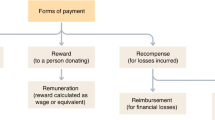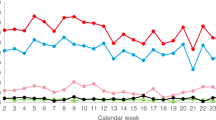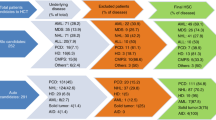Abstract
Minority donor programs aim to improve access to unrelated hematopoietic SCT for specific ethnic groups through directed donor recruitment. We have developed criteria for initiation and evaluation of such programs and applied them to the situation of donors of Turkish descent in Germany, as well as a program by DKMS German Bone Marrow Center that targets this group. Criteria for program initiation include the number of accessible minority donors, potential impact on the chances of finding matching donors, and general access to unrelated transplantation for patients of the targeted group. Success criteria comprise number and availability of recruited donors, the effect of these donors on the HLA phenotype distribution of a donor file, and the number of donations resulting from the program. More than 40 000 donors of Turkish descent have been recruited within the analyzed program to date. Recruited minority donors show more favorable demographic characteristics but lower availability rates than do German donors. Although HLA haplotype distributions of Turkish and German donors differ considerably, patients with common Turkish HLA phenotypes should benefit from the German donor pool even without a specific minority program. The analysis of donations from minority donors, however, shows specific benefits for patients with rare HLA phenotypes.
This is a preview of subscription content, access via your institution
Access options
Subscribe to this journal
Receive 12 print issues and online access
$259.00 per year
only $21.58 per issue
Buy this article
- Purchase on Springer Link
- Instant access to full article PDF
Prices may be subject to local taxes which are calculated during checkout




Similar content being viewed by others
References
Beatty PG, Mori M, Milford E . Impact of racial genetic polymorphism on the probability of finding an HLA-matched donor. Transplantation 1995; 60: 778–783.
Oudshoorn M, Cornelissen JJ, Fibbe WE, de Graeff-Meeder ER, Lie JL, Schreuder GM et al. Problems and possible solutions in finding an unrelated bone marrow donor. Results of consecutive searches for 240 Dutch patients. Bone Marrow Transplant 1997; 20: 1011–1017.
Confer DL . The National Marrow Donor Program: meeting the needs of the medically underserved. Cancer 2001; 91: 274–278.
Kollman C, Abella E, Baitty RL, Beatty PG, Chakraborty R, Christiansen CL et al. Assessment of optimal size and composition of the US National Registry of hematopoietic stem cell donors. Transplantation 2004; 78: 89–95.
Switzer DE, Dew MA, Harrington DJ, Crowley-Matoka M, Myaskovsky L, Abress L et al. Ethnic differences in donation-related characteristics among potential hematopoietic stem cell donors. Transplantation 2005; 80: 890–896.
Tiercy JM, Nicoloso G, Passweg J, Schanz U, Seger R, Chalandon Y et al. The probability of identifying a 10/10 HLA allele-matched unrelated donor is highly predictable. Bone Marrow Transplant 2007; 40: 515–522.
World Marrow Donor Association. www.worldmarrow.org.
Brunstein CG, Baker KS, Wagner JE . Expanding the role of umbilical cord blood transplantation. Br J Haematol 2007; 137: 20–35.
Kollman C, Howe CW, Anasetti C, Antin JH, Davies SM, Filipovich AH et al. Donor characteristics as risk factors in recipients after transplantation of bone marrow from unrelated donors: the effect of donor age. Blood 2001; 98: 2043–2051.
Schmidt AH, Biesinger L, Baier D, Harf P, Rutt C . Aging of registered stem cell donors: implications for donor recruitment. Bone Marrow Transplant 2008; 41: 605–612.
Cavalli-Sforza LL, Edwards AW . Phylogenetic analysis. Models and estimation procedures. Am J Hum Genet 1967; 19: 233–257.
Excoffier L, Laval G, Schneider S . Arlequin (version 3.0): an integrated software package for population genetics data analysis. Evol Bioinform Online 2005; 1: 47–50.
Excoffier L, Slatkin M . Maximum-likelihood estimation of molecular haplotype frequencies in a diploid population. Mol Biol Evol 1995; 12: 921–927.
Guo SW, Thompson EA . Performing the exact test of Hardy-Weinberg proportion for multiple alleles. Biometrics 1992; 48: 361–372.
Auswärtiges Amt. www.auswaertiges-amt.de.
Kollman C, Weis T, Switzer GE, Halet M, Kitajima D, Hegland J et al. Non-HLA barriers to unrelated donor stem cell transplantation. Bone Marrow Transplant 2001; 27: 581–587.
Diler AS, Karaman V, Yesildag I, Yalman N . Describing the actual status of a Turkish bone marrow registry. Tissue Antigens 2008; 71: 377–378 (Abstract).
Bone Marrow Donors Worldwide. www.bmdw.org.
Uyar FA, Dorak MT, Saruhan-Direskeneli G . Human leukocyte antigen-A, -B and -C alleles and human leukocyte antigen haplotypes in Turkey: relationship to other populations. Tissue Antigens 2004; 64: 180–187.
Beksac M, Dalva K . HLA-A, -B, -C, -DR haplotypes, linkage and frequencies observed in Ankara University, Turkey: a report from TRAN. Tissue Antigens 2008; 71: 373 (Abstract).
Gratwohl A, Baldomero H, Frauendorfer K, Urbano-Ispizua A, Niederwieser D . Results of the EBMT activity survey 2005 on haematopoietic stem cell transplantation: focus on increasing use of unrelated donors. Bone Marrow Transplant 2007; 39: 71–87.
Jahresbericht 2007. Deutsches Register für Stammzelltransplantationen. www.drst.de.
Gratwohl A, Baldomero H, Frauendorfer K, Rocha V, Apperley J, Niederwieser D . Results of the EBMT activity survey 2006 on haematopoietic stem cell transplantation: focus on the use of cord blood products. Bone Marrow Transplant 2008; 41: 687–705.
Lee SJ, Klein J, Haagenson M, Baxter-Lowe LA, Confer DL, Eapen M et al. High-resolution donor-recipient HLA matching contributes to the success of unrelated donor marrow transplantation. Blood 2007; 110: 4576–4583.
Author information
Authors and Affiliations
Corresponding author
Rights and permissions
About this article
Cite this article
Schmidt, A., Solloch, U., Baier, D. et al. Criteria for initiation and evaluation of minority donor programs and application to the example of donors of Turkish descent in Germany. Bone Marrow Transplant 44, 405–412 (2009). https://doi.org/10.1038/bmt.2009.55
Received:
Revised:
Accepted:
Published:
Issue Date:
DOI: https://doi.org/10.1038/bmt.2009.55



